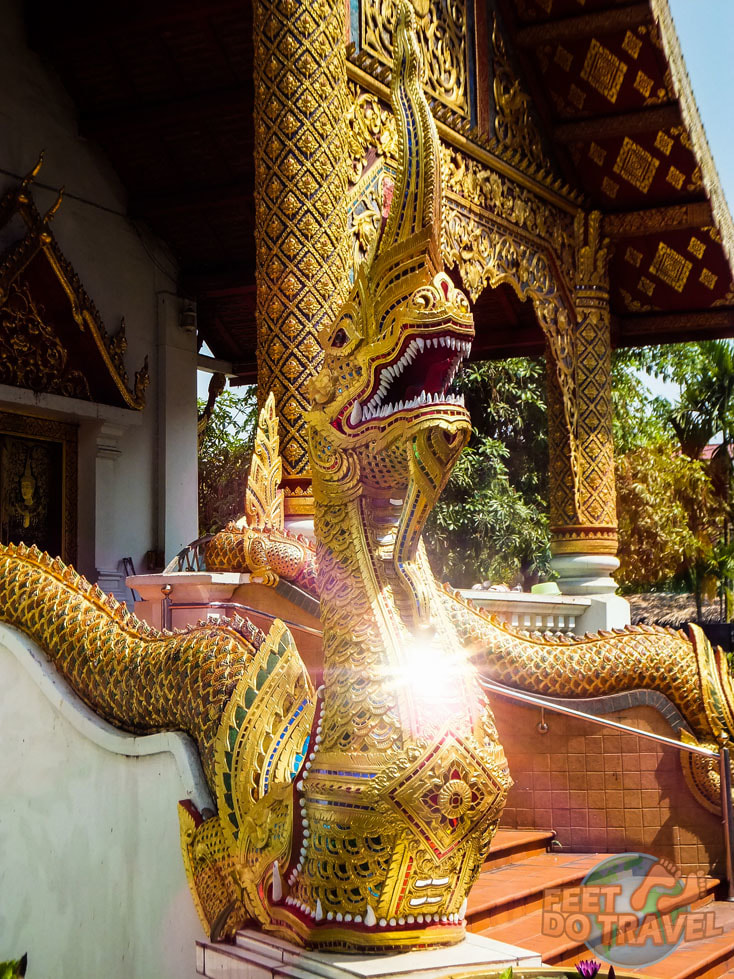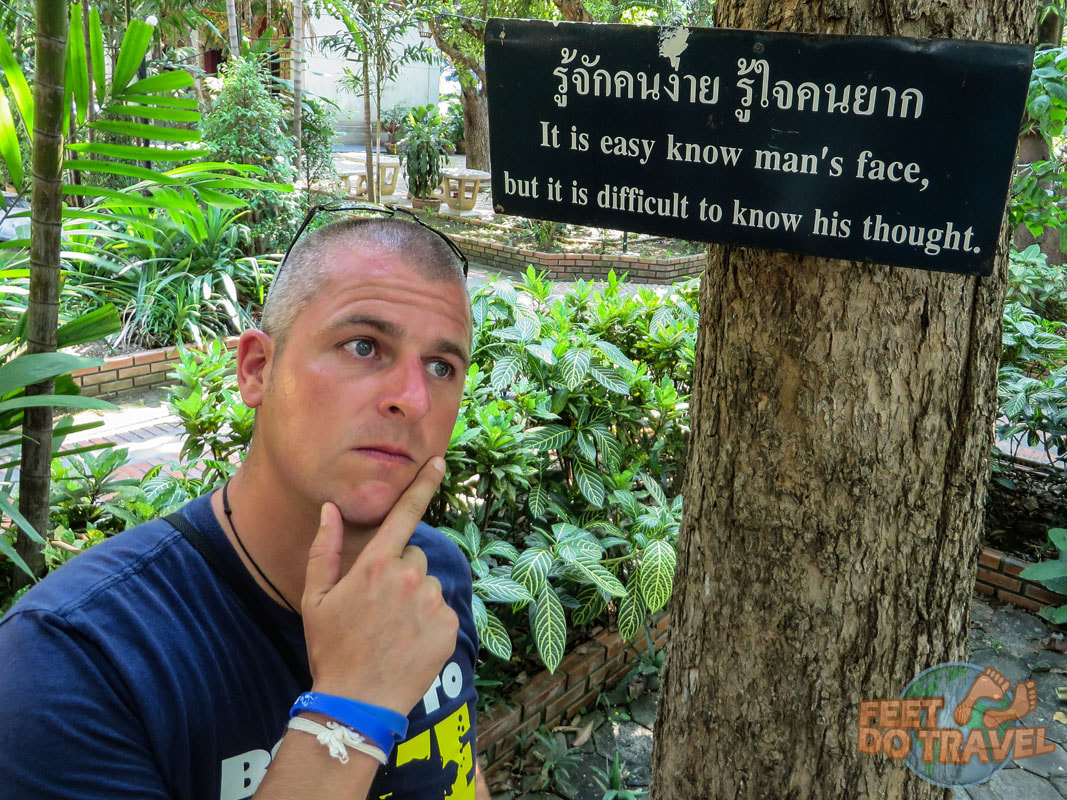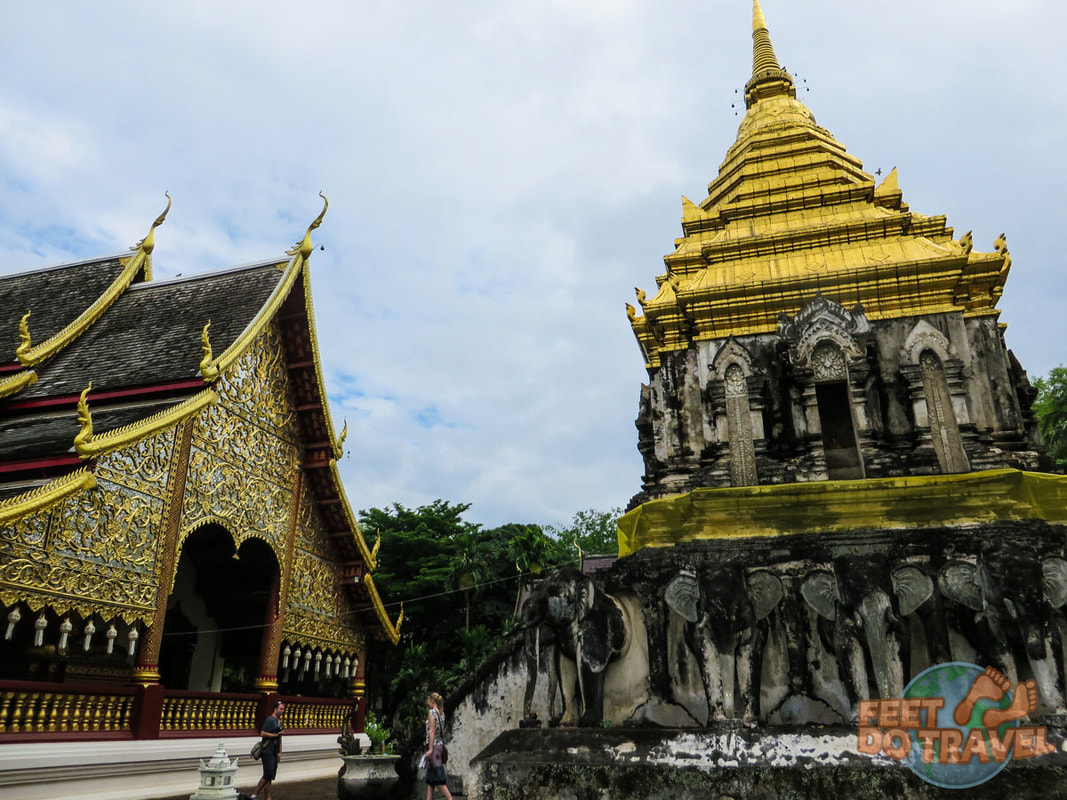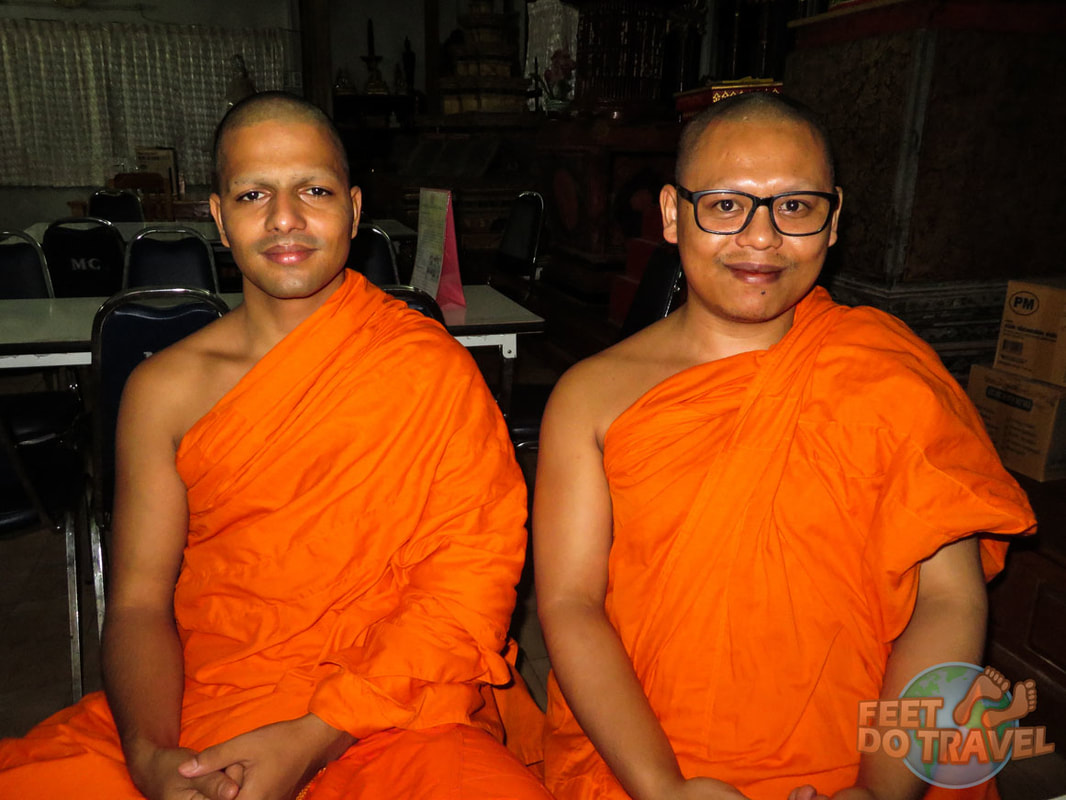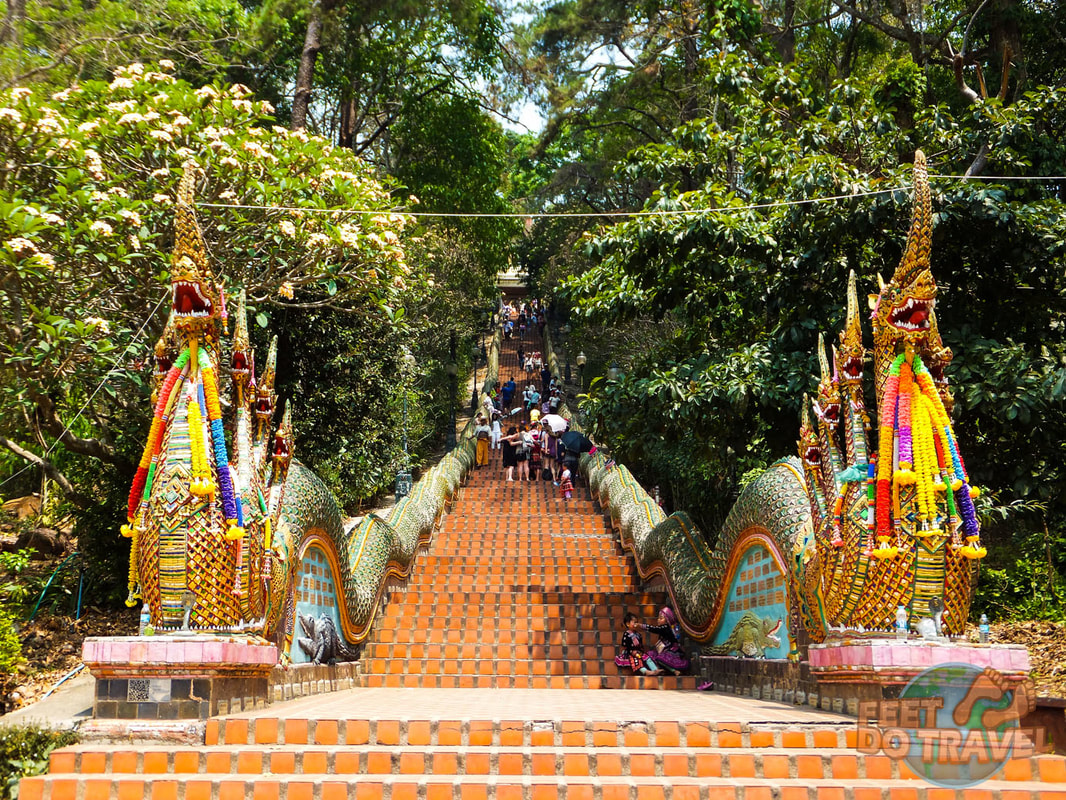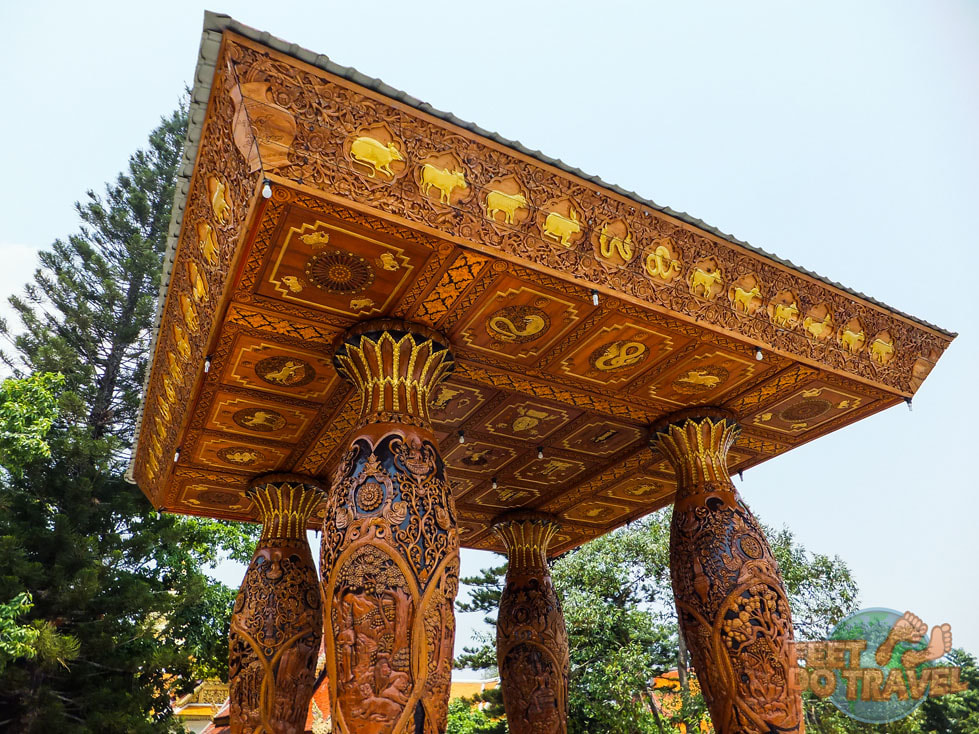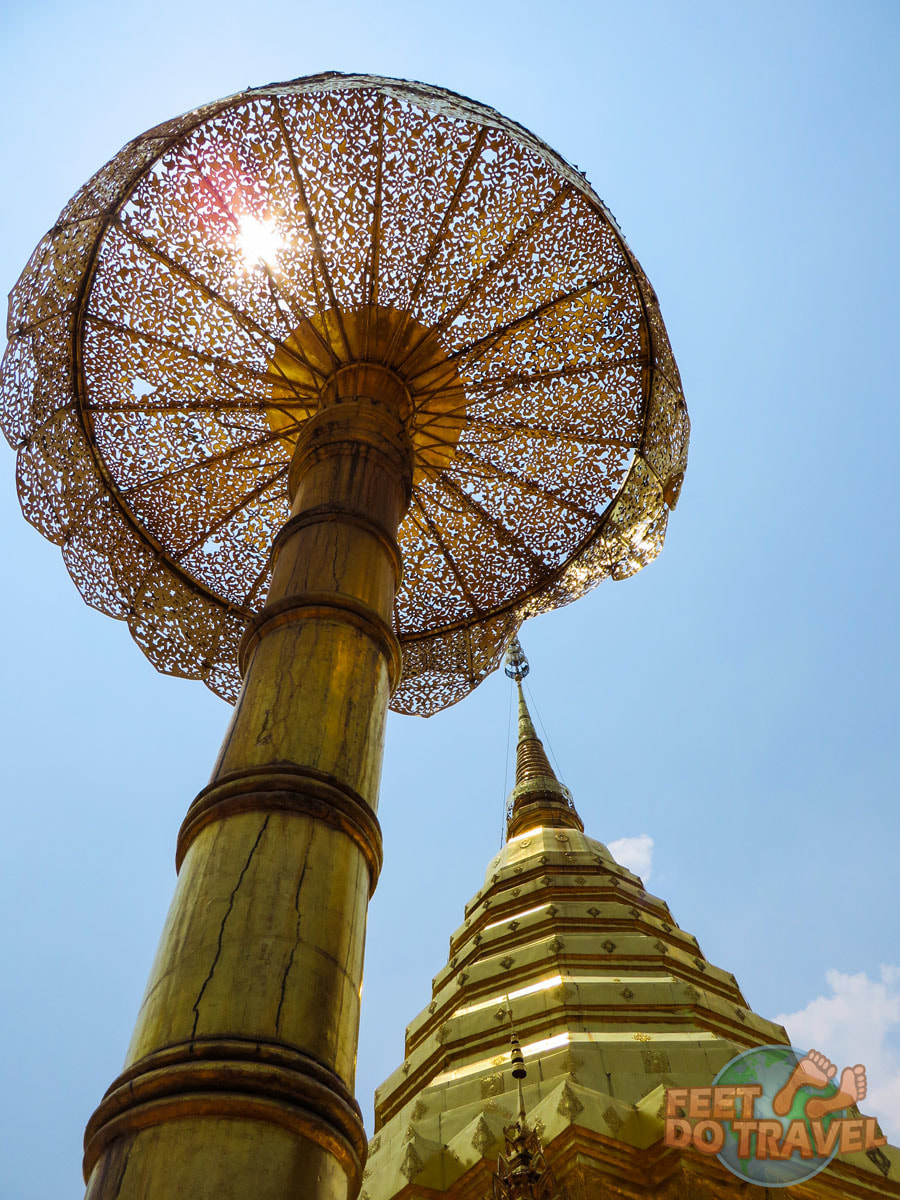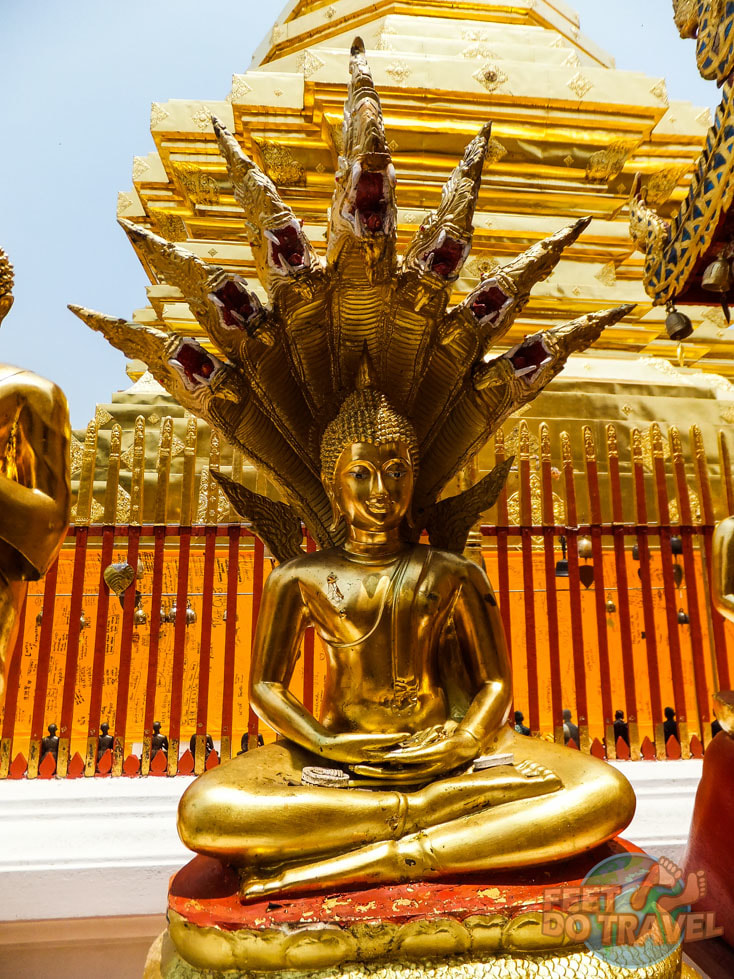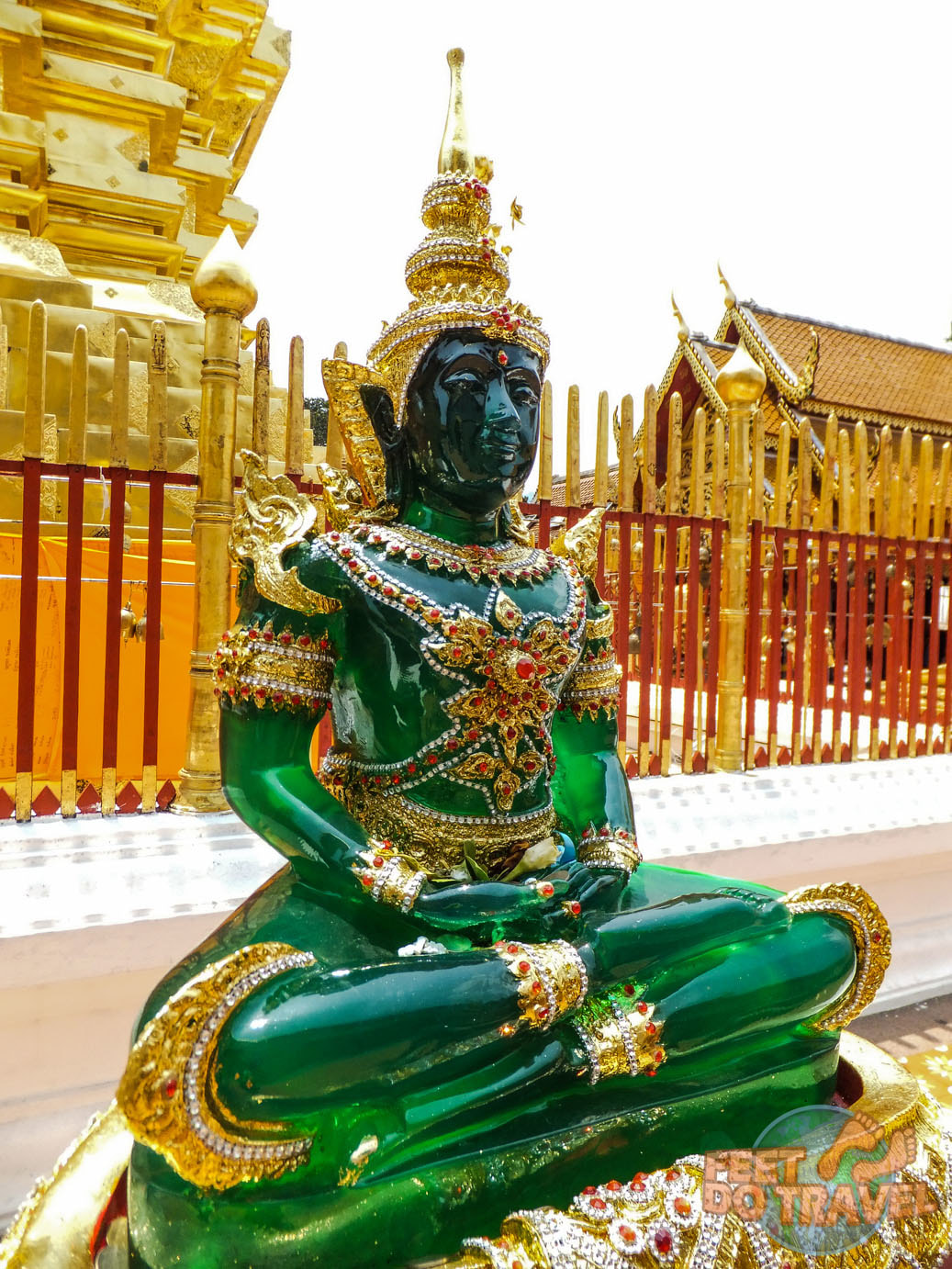With a mixture of old temples, cultural temples, temples of huge historical importance, it is easy to see how Chiang Mai was once the capital of Thailand. The myths surrounding their origins are fascinating, and we doesn't love a gold Buddha statue or two.
An Old City Temple Tour is where you will see the majority of temples, but if you make time to visit Doi Suthep, you will not be disappointed.
Feet Do Travel share what we consider to be the best temples to visit in Chiang Mai.
First, I must start with Temple etiquette as this is extremely important.
When visiting Temples, you are reminded to be respectful of the Monks’ religion, beliefs and way of life. As tourists, we should remember we are visitors so must dress and act in a way that does not offend. Sadly, we saw too many visitors walking around in tiny shorts, small vests or see-through tops with plenty of flesh on display.
A Temple is not a place to show off your body, it is a place of worship and if you visit, please treat it with respect. If you are hot and wear less clothes on holiday, carry a sarong around with you so you can easily cover up for those small periods of time.
You will notice that all Temples in Thailand begin with “Wat”. This is a temple complex that includes a building where prayers take place and Buddha statues are displayed. Many temples contain a chedi which are also called a stupa or pagoda, and is a structure which was originally used to contain relics of Lord Buddha. In later years they were also used to enshrine remains of Kings or very important monks.
The majority of temples in Chiang Mai are Lanna style which was the Kingdom of North Thailand from 13th – 18th centuries.
Naga serpents are large mythological snakes, are often found protecting the entrance of Buddhist Temples, and usually contain beautiful mosaics and stones.
Some say once you have seen one Temple you have seen them all, but if you delve further into their history there are always interesting differences. The Temples we chose to visit had a large amount of historical importance in some way.
If you want to only do the Old City Temple Tour, most travel books have a section dedicated to this walk so you can do it yourself at your leisure, alternatively you can book one of the many advertised tours .
These temples in this article are listed in the order we visited, not our order of preference.
1. Wat Phra Singh
Entrance: 20 baht (until 5pm) 5pm – 8pm - FREE
Opening hours: 6.00am – 8.00pm
Location: Ratchadamnoen Road
Wat Phra Singh was built in 1345 by King Pha Yu who had the chedi built to house the ashes of his father. It is the main Temple in Chiang Mai Old City and a point of reference for most people, I personally think this is one of the top three you should visit as it’s rather impressive. Pilgrims come here to view the famous Phra Buddha Singh statue which roughly means “Lion Buddha” and is housed in a small chapel south of the chedi.
During Songkran, when we visited, this statue is carried through the streets as part of the procession, and is considered to be the holiest in Chiang Mai. The Lion Buddha statue came from the Mahabodhi Temple in Bodhgaya, India where Buddha gained enlightenment.
Entrance: FREE
Opening hours: Unfortunately I haven’t been able to find out!
Location: Ratchadamnoen Road
A short distance from Wat Phra Singh, I will be honest and say this is the most controversial and unexpected Buddhist Temple I have visited. Ever. And I have visited countless numbers of Temples in my time, including The White Temple in Chiang Rai.
The entrance to this Temple is just like any other temple; the stairs are adorned with beautiful gold and green naga serpents. However, when we stepped inside to admire the paintings, I was left with complete confusion.
As this temple is so different to all the other temples, I have added it to this list.
Entrance: FREE
Opening hours: 8.00am – 5.00pm
Location: Phra Pokklao Road
This old teak wooden temple is visually different from others and often overlooked for its more popular neighbour, Wat Chedi Luang.
Construction began in the 1300’s and Wat Phan Tao means “Temple of a Thousand Kilns”. It isn’t very large or as impressive as others, however we had the pleasure of watching Monks here on a pilgrimage. As they walked along a bamboo bridge, they rang the bells and posed for photographs of each other using their mobile phones.
Entrance: FREE
Opening hours: “During daylight hours”
Location: Soi Inthakin
Another visually different Temple is Wat Inthakhin Saduemuang, but this is made of black teak wood with gold gilt edging.
Built in 1296, this temple isn’t very popular with tourists so it isn't crowded, and this is the reason I have included it.
Entrance: FREE
Opening hours: 08.00 – 17.00
Location: The corner of Phra Poklao Road soi 13 and Ratchaphakhinai Road (North East corner of the old town)
If you want to visit the oldest Temple in the City, then come to Wat Chiang Man.
Built around 1296 at the time the City was founded by King Mengrai, it was once the king’s residence. Its name means Temple of the Fortified City.
Two very important Buddha images are housed here, the crystal Phra Satang Man Buddha has been here for 1,800 years and the Marble Phra Sila Buddha for 2,500 years.
Entrance: FREE
Opening hours: 6.00am – 6.00pm
Location: The Super Highway, northwest of the Old City
Wat Jed Yod means “Seven Peaks” and refers to the seven spires on the top of the structure. Apparently this temple is a copy of the Mahabodhi Temple in India and was built around 1453.
The seven spires represent the seven weeks Lord Buddha spent at Bodhgaya (India) when in search of enlightenment. Unfortunately, we didn’t time our visit temple very well, and arrived just as it was closing.
Entrance: FREE
Opening hours: 6.00am – 7.00pm
Location: Suthep Road
Wat Suan Dok isn’t very popular with tourists, maybe because it’s not in the centre of the Old City, however it has many reasons to visit, one of them being a lovely sunset. We feel we timed our visit perfectly. We had time to wander the grounds whilst the sun was still in the sky, then watched the sunset.
We took part in Monk Chat, and finished when it was dark so were able to view the temple at night.
This Temple features heavily in the legend which founded Doi Suthep but has far less visitors and isn’t considered to be as important. Here is the story; a wandering monk carrying a piece of Buddha’s shoulder bone arrived here and the relic split into two. A chedi was built to house the relic, and It was from this temple the King placed the other half on a sacred white elephant. The elephant walked to Doi Suthep mountain and died, the chedi at Wat Pra Doi Suthep was then built to house the other half of Buddha’s relic.
As we entered the temple grounds, we were greeted by white washed pagodas which are mausoleums holding the ashes of past rulers and important nobles. Inside the temple there are plenty of gold Buddha’s to satisfy any budding jackal.
Monk Chats are a hugely important part of a monk’s social duties. They valued their time with us, it helps their spoken English, and they learn more about a life they do not lead. By chatting with the monks, you are sharing valuable information and, as sharing is a value taught in Buddhism, this is an important part of their learning. If you want to know more, read our blog post “It’s a Monk’s Life”.
Entrance: 30 baht
Opening hours: 6.00am – 6.00pm
Location: Wat Phra That Dli Suthep Road Tambon Su Thep
Doi Suthep Temple is 15km out of Chiang Mai and is super easy to find if you want to travel by scooter which cost 250 baht for 24 hours. The winding mountain road is a lovely smooth ride and, on a hot, humid April day, the cool breeze on our faces was a welcome relief.
If you don’t want to take a scooter, grab a red taxi (songthaew) from Chiang Mai centre. If it is full with 10 people per taxi, expect to pay around 100 baht per person for the return trip (if you don’t want to wait for the taxi to be full, you can haggle and pay a bit more).
As one of the holiest Buddhist sites in Thailand, it is a major pilgrimage destination, especially during Buddhist holidays on 13 February and 11 May.
The founding of this Temple is shrouded in Thai myths and magic and is taught to all school children in Chiang Mai.
The story is told that a wandering Monk found the shoulder bone of Buddha. One half of the bone is housed at Wat Suan Dock (where we had monk chat), the other half was placed by the King onto the back of a sacred white elephant who wandered the jungle until it died at the foot of Doi Suthep mountain. It was decided that Doi Suthep would be the place the Buddha’s relic would be housed, and it lays within the gold Chedi at this temple.
Be warned: I have since read they have been known to steal from unsuspecting tourists having photos taken with them. I did see their plain clothed parents hiding behind the wall when I investigated further.
There is a large wooden piece at the top which is carved so intricately, it is stunning. A shrine to the white elephant and the story of how the temple was founded is here for all to see.
In the centre there is a golden spire 24 metres tall and at the four corners are four gold umbrellas which sparkle in the bright sun. Miniature chapels display richly decorated Buddha images and countless gold Buddha’s adorn every inch of the walls.
Pilgrims show their respect in a number of ways; monetary donations; circling the pagoda three times reading out phrases whilst carrying lotus flowers; lighting candles/incense and praying three times, kneeling on the floor and bowing three times to one of the plethora of Buddha statues.
If you want to explore more of Chiang Mai’s mountainous region and temples, the cheapest and most convenient way is to hire a scooter.
I had always said I would never ride a scooter in Thailand after hearing all the horror stories of accidents and dodgy hire companies, however we put our faith in the ladies at our Homestay who arranged the scooter for us and, thankfully, everything turned out OK.
You do not need an International Driving Licence in Thailand provided your licence displays a photograph and is in English. We are from the UK so our licence complies but if you are unsure, check the driving in Thailand website for regulations.
It’s always best to give your scooter a once-over before setting off; check the tyres, brakes and ensure that any scratches/dents are photographed and pointed out to ensure you aren’t later blamed for them.
Don't fall for police bribes
We were warned by the ladies at our Homestay that the police sometimes try to bribe you. Police tell you your licence is invalid and ask for an on-the spot fine. Sometimes they try to take your licence but the ladies at the Homestay told us never to hand it over. We were told that if we did get a fine, we were to go to the police station and pay it.
We had read the laws before we hired a scooter so knew our rights and, when we were stopped, we were fully prepared. As mentioned, we were here during Songkran, the busiest time of year, so the police were simply checking our licence was a valid. The second time we were stopped it was to ask if we had been drinking (obviously we hadn’t, we value our lives). Drink driving during Songkran is commonplace.
Don’t forget to wear a helmet, you would be a fool if you don’t!
Have you visited the Temples of Chiang Mai? Which was your favourite? Did you miss any out and regret it? Tell us your thoughts in the comments section below.
Flying: All major airlines fly to Bangkok, then take a short internal flight, Air Asia are the cheapest and most popular.
Sleeper Train from Bangkok: If you are picturing a rickety old train with awful sleeping conditions next to chickens and old men, think again! They are modern, clean and super efficient. We checked the schedules online and booked in advance via 12GoAsia. The office is located across the road from Bangkok’s Hua Lamphong train station; buying and picking up the tickets couldn’t have been easier and I would thoroughly recommend them!
Where to stay
We stayed outside of the old town, about a 20 minute walk/10 minute bike ride away at Banilah Boutique Guest House (email: [email protected]). We would thoroughly recommend them, they are friendly, efficient and provide very thorough information and maps for the area.


Book your Chiang Mai, Thailand or any short break/holiday hotel through our website. We always use and recommend Booking.com, and are proud to have a partnership with them. Visit our Hotel Booking Page then search as normal.
My Chiang Mai
Elephant Valley Thailand: Where Elephants Come First
Why You Should Visit Chiang Rai
Temple-Tastic Chiang Rai
Songkran - Soaking Up The Atmosphere
Ping Pong at Patpong: Sex Tourism or Sexy Show?
It's A Monk's Life (Interview with Buddhist Monks)
Visiting Thailand: The Etiquette and More
6 Best Floating Markets in Thailand
7 Reasons to Visit Koh Samui








